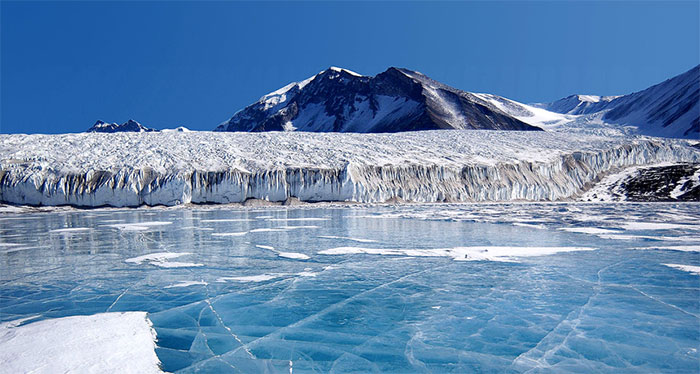Chinese scientists discovered 46 subglacial lakes in Antarctica
Chinese scientists have discovered 46 more subglacial lakes in Antarctica using an innovative analysis method.
Antarctica is covered by a vast mass of ice with an average thickness of more than 2,400 meters. Beneath this ice sheet exist many diverse subglacial lakes.
According to Tang Xueyuan, a research team leader at the China Polar Research Institute (PRIC), these lakes are formed when ice streams melt through depressions in the bedrock beneath the ice sheet.
"Research on subglacial lakes in Antarctica is of critical importance in understanding ice sheet dynamics, sedimentation processes, subglacial geochemical cycles as well as the evolution of ice sheets," Tang said. living".
Many studies have shown these lakes fill and drain in mysterious cycles that can affect how fast the ice sheet moves and how and where meltwater reaches the Southern Ocean.

Antarctica's subglacial lakes fill and drain in mysterious cycles. (Photo: Science News Explore)
Scientists have introduced a new method that uses a variational autoencoder (VAE) to analyze the ice bottom reflection waveform characteristics shown in ice radar data. Using this method, the team conducted comprehensive scans of ice radar images in the AGAP-S region of the Gamburtsev Subglacial Range in East Antarctica.
The results show the existence of 46 subglacial lakes characterized by geometrical contours significantly smaller than those identified by conventional methods. Scientists believe that this new method significantly improves the efficiency and accuracy of subglacial lake exploration and also promises to expand the discovery and study of more types of subglacial environments in Antarctica.
This research was conducted by teams from PRIC, China University of Geosciences (Wuhan) and Southern University of Science and Technology.
According to current statistics, scientists around the world have discovered a total of 675 subglacial lakes beneath the Antarctic ice sheet, of which 3 have been successfully drilled and sampled.
- Climate change causes snow in Antarctica to turn green
- Deciphering the blood waterfall 'mystery in Antarctica
- The first time the map covered the entire Antarctic region
- Huge 'Ocean' under the dry desert in China
- Japan discovered 4 small meteorites in Antarctica
- Discovering huge lakes in the Antarctic ice
- Discover the first plane on Antarctica
- China: 70% of rivers and lakes are polluted
- 90 million years ago, West Antarctica was a vast rain forest
- Exotic animals in Antarctica
- Scientist 'went out' to clean up rivers and lakes
- New discovery about the existence of Antarctic penguins
 Is the magnetic North Pole shift dangerous to humanity?
Is the magnetic North Pole shift dangerous to humanity? Washington legalizes the recycling of human bodies into fertilizer
Washington legalizes the recycling of human bodies into fertilizer Lightning stone - the mysterious guest
Lightning stone - the mysterious guest Stunned by the mysterious sunset, strange appearance
Stunned by the mysterious sunset, strange appearance